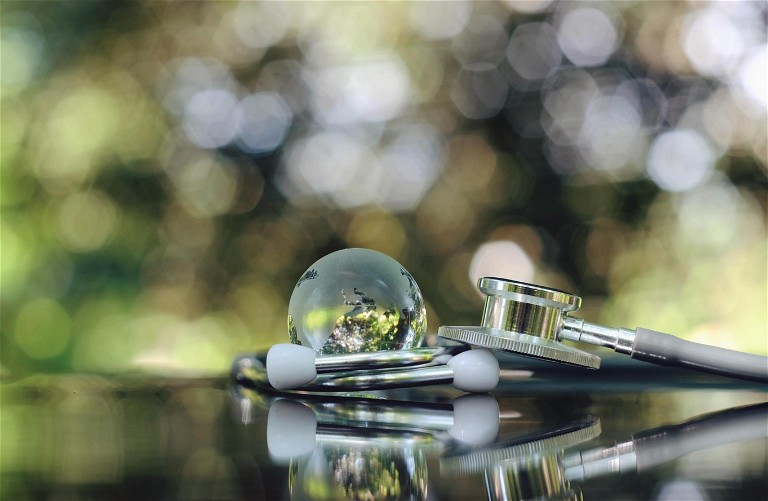Industry Insight
Sustainable drug delivery devices: striking a balance between future aspirations and current possibilities
Alex Fong and Olivia Houselander from Owen Mumford Pharmaceutical Services consider the action needed to make drug discovery processes more sustainable

Whether motivated by internal sustainability goals or external regulatory pressures, the drive to a more sustainable future is a key consideration for all in healthcare-related fields. In the UK, the NHS is responsible for around 4% of the country’s carbon emissions and has ambitious goals to reach net zero for Scope 1, 2 and 3 by 2045.1 Yet this can only be achieved with the support of its partners.
Within the drug delivery device sector, single-use plastics have long been the preferred material due to their ability to ensure safe and effective administration of medication to patients. In the longer term, we are likely to see these being replaced by bioplastics or recycled materials, but at present, suitable products are not market-ready. However, there is still much device manufacturers and their pharmaceutical partners can do to create a more sustainable industry in the immediate future.
The plastics problem
As we look to reduce plastic consumption within the medical device space, a first step is to take stock of material use across the entire marketplace. This allows us to identify where we can quickly and most easily make changes that will have the biggest impact.
Classifying products based on their potential for substitution without loss of utility, sterility or safety is a crucial starting point. For instance, studies have shown that there are significant opportunities to substitute plastics used in packaging, disposable masks, gloves, coverings and wound care without compromising safety or products.
One study shares that the majority of medical waste is made up of commodity plastics used to make tubing, packaging, catheters, facemasks and more.2 It seems logical to begin by making changes to these lower-risk products in the immediate term. Meanwhile, syringes and other invasive devices must, by necessity, be lower down the list of priorities for reform until we find suitable solutions that ensure drug stability, anti-contamination and infection control.
In the interim, suppliers and buyers in the drug delivery device sector can work together to ensure products provide the best outcomes for clinicians and patients. For now, this will mean the continued use of plastic single-use drug delivery devices. However, there are methods of minimising their carbon footprint to achieve critical progress on the sustainability front until suitable alternative materials become available.
Some pharma companies have developed products such as auto-injectors to suit the needs of the modern pharmaceutical sector.
These need to allow compatibility with a range of different formulations, fill volumes, needle sizes and primary containers. With changes to formulation and dosage common during the development of injectable drug delivery products – and throughout their life cycle – this kind of flexibility provides a safety net; should a change occur, pharma companies will not need to find an entirely new delivery device.
Removing the risk of a device change in the event of formulation changes simultaneously eliminates the need for additional verification testing, human factors studies and regulatory documentation, which can all increase development cost and delay time-to-market. This has the further benefit of supporting sustainability goals since pharma companies can use a single platform for multiple applications; streamlining facilities in this way reduces the environmental impact of products at the manufacturing stage.
Sustainability by design
Despite some products being single-use, decisions made during the early stages of development can reduce their overall environmental impact through a ‘sustainability by design’ approach. To create a truly sustainable product, designs must assess the entire life cycle of a product, not just the product itself, ie, the journey from design, material selection and engineering to manufacturing, packaging and end-of-life disposal. Suppliers are already applying this holistic approach to strengthen manufacturing efficiency, time to market, risk reduction, safety and regulatory compliance, as well as packaging and transportation costs. However, there are opportunities to go further to minimise environmental impact.
Here are a few examples: creating a product that is easy to disassemble makes recycling methods simpler and cheaper; taking steps to simplify devices, optimise their size and reduce packaging can help to cut waste and transportation costs; taking opportunities to remove or replace non-essential metal components is beneficial due to the carbon impact of processing and shipping metals compared to polymers; ensuring an entire range of products uses similar raw materials and production methods can also reduce cost and waste produced in the manufacturing stage, while also allowing flexibility between production lines.
What about reusability? As mentioned above, it is clear that drug delivery devices need to retain disposable elements to ensure hygiene and safety standards are met. However, for auto-injectors, the most appropriate solution for now is to create a reusable ‘shell’ with a disposable element. This is also a viable option for connected or digital products. While devices with connected capabilities or digital features enable numerous benefits in terms of cost, remote patient monitoring and self-administration, introducing disposable electronics to devices would clearly be counterproductive from both a financial and sustainability point of view. However, a reusable electronic component within a disposable device could allow companies to take advantage of digitalisation in an efficient way.
Balancing sustainability with interchangeability
As the device landscape evolves, the issue of interchangeability is likely to come up. Opting for a disposable device creates a more straightfor ward route to market from a regulatory point of view, as patients may have difficulty switching to reusable and remanufacture-able devices. However, persisting with this status quo is clearly not the best option for the long term. Companies must therefore strike a balancing act between creating more sustainable products and ensuring seamless device interchangeability both from a regulatory and clinical perspective.
Ultimately, the industry is constantly dealing with a dilemma. For pharma companies, the choice – crudely speaking – is between sustainability and competitiveness, and for regulators and clinicians, it is between sustainability and adoption likelihood.
This question is especially likely to arise in relation to biosimilars, since new market entrants may come with a different device from the original biologic. Pharmaceutical companies need to know that any change of device does not negatively impact the patient experience or increase risk of nonadherence to treatments. Identifying the most suitable device for their biosimilars therefore requires data from human factors testing to determine the ease-of-use of a product. This data can then support regulatory applications for interchangeability status.
Short-term actions and long-term plans
In the long term, we know the make-up of drug delivery devices will look vastly different from current products. Damaging plastics will be phased out as we develop new materials that can suitably replace them. Yet, until these materials have been thoroughly tested and are widely available, we must continue to optimise current product lines. Making strides to minimise the environmental impact of single-use devices starts by examining the entire product life cycle and understanding where progress can be made. For this, collaboration between suppliers and buyers will be fundamental to achieving and speeding up success.

Alex Fong MBA is an experienced senior manager in the Insight, Analytics and Strategy fields. He has applied these skills in a broad range of industries including the FMCG/CPG, tourism, Investment banking, telecoms and management consulting sectors. For the last eight years Alex has been leading the market research drive at Owen Mumford, with an ever-increasing focus on sustainability.

Olivia Houselander joined Owen Mumford as a product manager in 2008 and currently serves as an accomplished business development manager in the Pharmaceutical Services division. In this role, she is applying her extensive experience in medical devices, marketing strategy, and product launch and development to support continued business growth and create innovative product launches, making her an asset in the dynamic healthcare landscape.